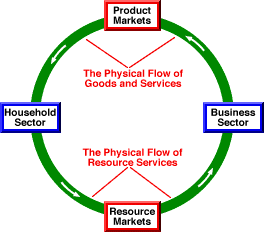
|
|
ZERO GROWTH: A growth rate (usually in terms of population) that is equal to zero. In other words, this is no change from one year to the next. This goal has been proposed by those who content that population growth is placing excessive pressure on the planet's availability of limited resources and its ability to assimilate pollution. In general terms, zero growth can apply to any measurement, including production, prices, etc.
Visit the GLOSS*arama
|
|


|

|
                           PHYSICAL FLOW: In the circular flow model, the transfer of goods and services from the business sector to the household sector and the transfer of resource services from the household sector to the business sector. The physical flow is usually illustrated as a counter-clockwise flow for a model with the product markets at the top, resource markets at the bottom, household sector at the left, and business sector at the left. The payment flow moves in the opposite direction. The physical flow, the physical movement of goods and services, is the foundation of the circular flow model. The fundamental problem of scarcity is addressed by physically transforming scarce resources into goods and services that are then used to satisfy wants and needs. This requires the physical exchange of commodities between the household sector, which has the resources, and the business sector, which produces the goods.A Simple ExampleFor example, when Alicia Hyfield buys a Waldo's Super Deluxe TexMex Gargantuan Taco this taco "flows" from the Waldo's TexMex Taco World in the business sector through the product markets and ends up in the possession of Alicia, a member of the household sector.In addition, the labor services of Edgar Millbottom, an employee of Waldo's TexMex Taco World, "flows" from the household sector through the resource markets and ends up with Waldo's TexMex Taco World in the business sector, where it is used in the production of an Waldo's Super Deluxe TexMex Gargantuan Taco. A Simple Model| The Physical Flow |  |
This diagram illustrates the physical flow aspect of the circular flow. This is, by the way, the simplest version of the circular flow model. This model contains two sectors. At the far left is the household sector, containing people seeking consumption. At the far right is the business sector doing the production. Two sets of markets are also included. At the top are the product markets that exchange final goods and services, or gross domestic product. At the bottom are the resource markets that exchange the services of the scarce resources.A reasonable starting point for tracing the payment flow is the household sector. Because it owns all resources, it supplies the services of these resources to the business sector through the resource markets. The business sector then uses the resources to produce the goods and services that are then supplied to the household sector through the product markets. This flow of resources from the household to the business sector and production from the business to the household sector is the physical flow. Running Through the Physical FlowHow about a few notable points on this physical flow?- First, focusing on product markets, the household sector is the demand-side and the business sector is the supply-side. Production flows from the business sector to the household sector through the product markets.
- Second, looking at resource markets, the household sector is the supply-side and the business sector is the demand-side. Resource services flow from the household sector to the business sector through the resource markets.
- Third, the household sector sells the resources through the resource markets and buys goods through the product markets. The household sector does the consumption. It supplies the resources that are used to produce the consumption goods that satisfy wants and needs.
- Fourth, the business sector buys resources through the resource markets and sells goods through the product markets. The business sector does the production. It buys the resources that it transforms into wants-and-needs-satisfying goods.
A Word About the Payment FlowThe physical flow of goods, services, and resources is countered by the payment flow that moves in the opposite direction. The payment flow is the movement of money payments from the household to the business sector in exchange for final goods and services and from the business to the household sector in exchange for the services of resources. The payment flow is usually represented as a clockwise movement.

Recommended Citation:PHYSICAL FLOW, AmosWEB Encyclonomic WEB*pedia, http://www.AmosWEB.com, AmosWEB LLC, 2000-2025. [Accessed: July 18, 2025].
Check Out These Related Terms... | | | | | | |
Or For A Little Background... | | | | | | | | | | | | |
And For Further Study... | | | | | | | | |
Search Again?
Back to the WEB*pedia
|



|

|
BROWN PRAGMATOX
[What's This?]
Today, you are likely to spend a great deal of time browsing through a long list of dot com websites seeking to buy either a case of blank recordable DVDs or a pair of red goulashes with shiny buckles. Be on the lookout for mail order catalogs with hidden messages.
Your Complete Scope
This isn't me! What am I?
|

|
|
Cyrus McCormick not only invented the reaper for harvesting grain, he also invented the installment payment for selling his reaper.
|

|
|
"A winner is someone who recognizes his God-given talents, works his tail off to develop them into skills, and uses those skills to accomplish his goals. " -- Larry Bird, basketball player
|

|
WAPM
Weak Axiom of Profit Maximization
|

|
|
Tell us what you think about AmosWEB. Like what you see? Have suggestions for improvements? Let us know. Click the User Feedback link.
User Feedback
|


|


